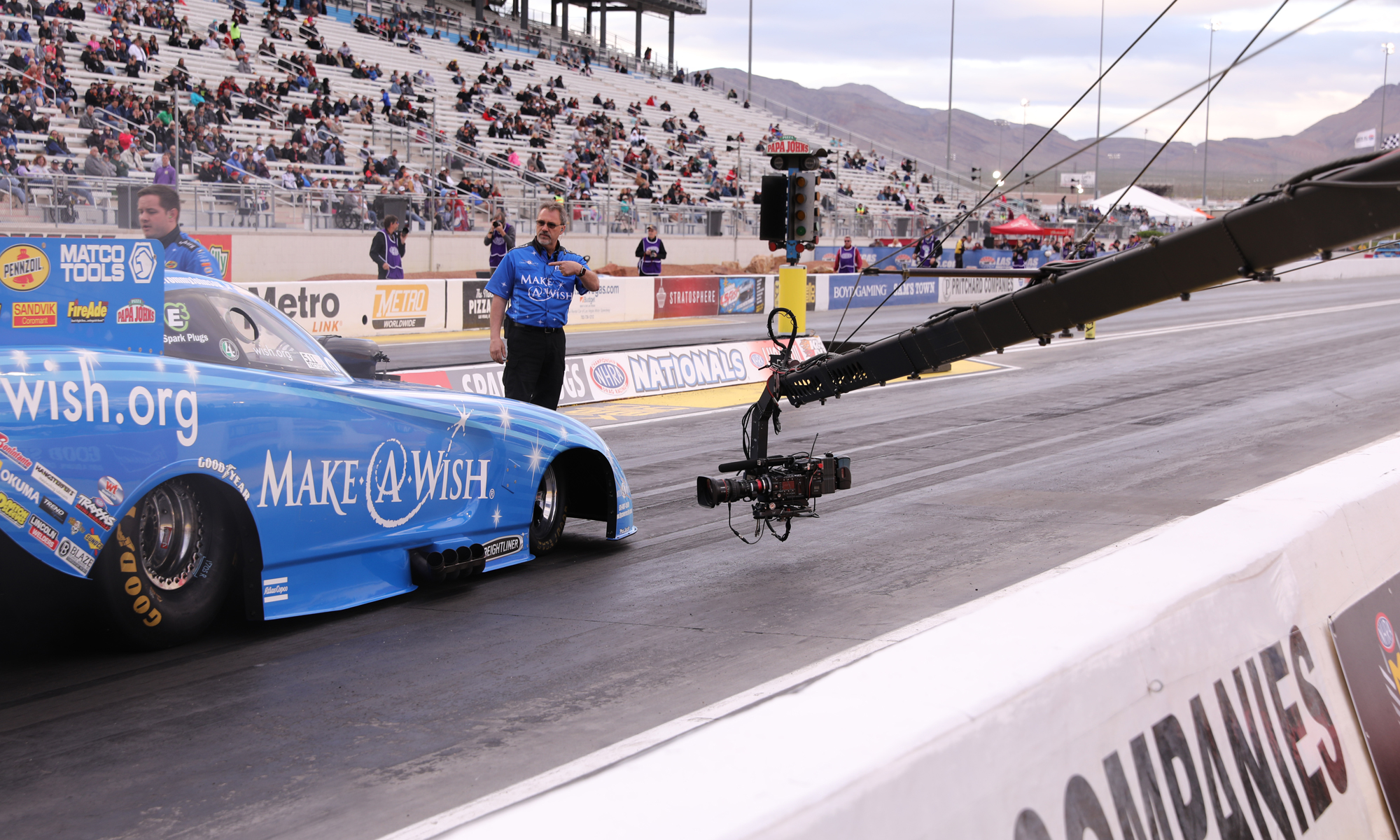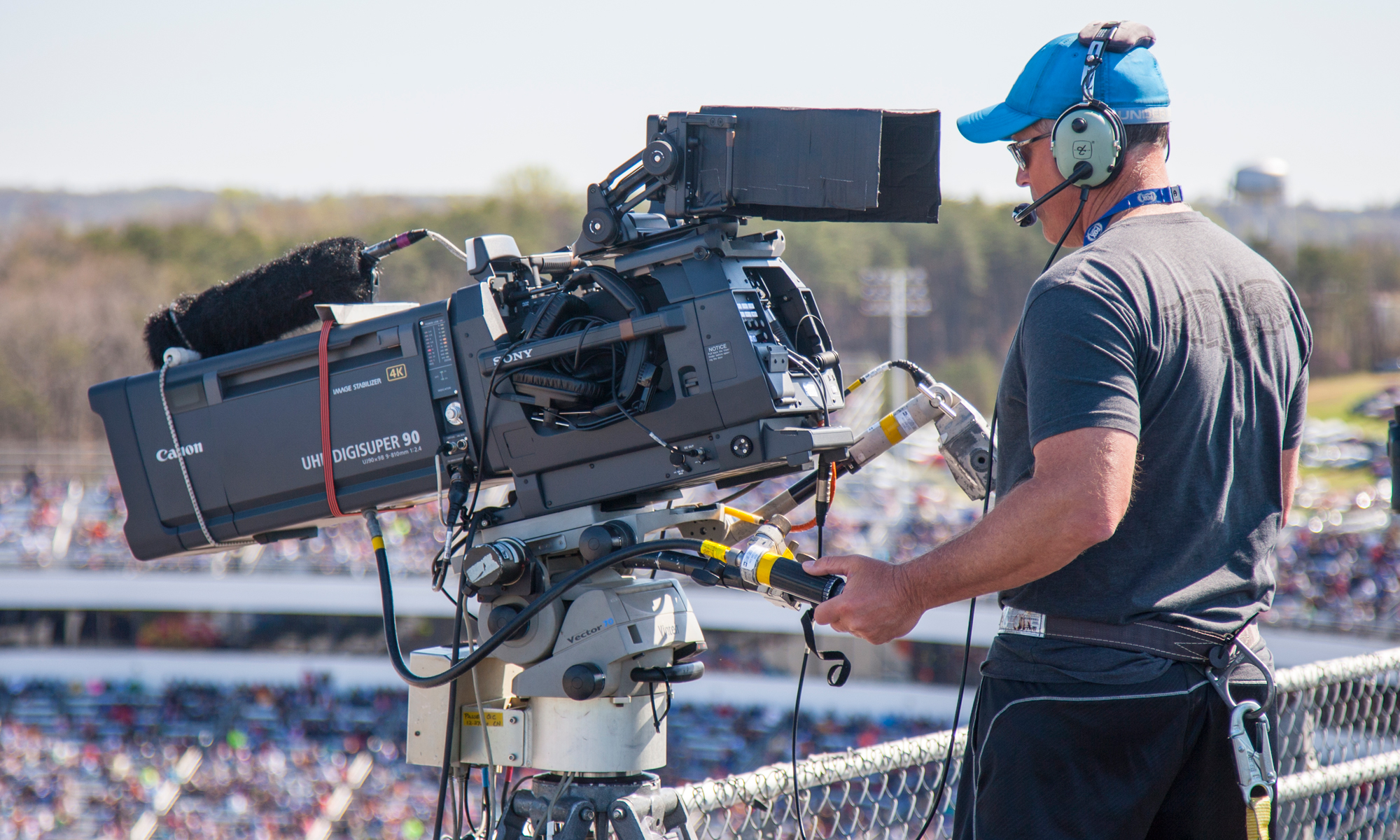NHRA, NASCAR Forays in 4K Use Proper UHD Canon Lenses
The tests produce significant improvement over cameras paired with HD lenses
Story Highlights
Auto racing is proving to be a fertile breeding ground for the sports-television industry’s continued adventures in 4K UHD production, and Canon has been playing a big role in tests related to the future of broadcast production. In the past month, major races on both the NASCAR and the NHRA schedule have seen 4K productions simulcast by the broadcaster via DirecTV.

The NHRA has experimented with both UHD and HDR acquisition technologies during various races this season.
NHRA Technology Executive Mike Rokosa had coupled the Sony HDC-4800 super-slo-mo camera with an HD broadcast lens. His goal was to see how the image quality improved with a variety of 4K and HD lenses.
Rich Eilers, national accounts sales director, professional products, Canon, was on hand for the tests, which were a crucial step in the NHRA’s continuing evolution. Earlier this year, its production team moved into Nitro, an all-new truck from Game Creek Video, which gives the racing association plenty of technical firepower.
The tests began with a true 4K Super 35mm PL-mount 50-1000mm lens followed by an 2/3-inch 86x premium 4K box field lens used with a B4-to-PL optical adaptor.
“We had a great deal of success with the F-4.5 PL-mount lens which delivered a bright image by not having to resort the the optical adaptor of the 2/3-inch lens (with its 2-stop light loss),” says Eilers.
The next day of race action saw the 86×1 box lens get the call and it stayed on the 4800 camera until Sunday. While there was some light loss (due to the B4-to-PL adapter) the high sensitivity of the camera made up for this — and the additional focal length proved very helpful. And given that the NHRA races occur in broad daylight it was found that the use of a 2x extender was even possible without image compromise.
“Sony was also out there with the F55 camera,” notes Eilers, “shooting some HDR content with our top-of-the-line lenses and taking advantage of the brilliant colors in the cars and the fire coming out of the engines.”
The result of the tests is that those who saw the pictures could see noticeable differences in what 4K optics can provide. And, although the move from HD to 4K may not have the same impact as the move from SD to HD, it still offers differentiation that, ultimately, makes the images better than those from the competition.
“The use of 4K gives a little more flexibility to the camera operators as they have the confidence to push in a little bit further. They are confident that the quality of the image won’t drop off, as it can keep 4K resolution in the corners,” Eilers explains. “As manufacturers, we need to be there for the clients during these tests, providing the tools so they can learn how best to affect the pictures and the production.”

Fox Sports fitted Canon 4K lenses on Sony 4K cameras during the production of a NASCAR race at Martinsville Speedway in Virginia this month.
On the NASCAR side, Fox Sports dove into 4K via FS1 and DirecTV this month at the STP 500 at Martinsville Speedway in Virginia. The network produced the race in a side-by-side shadow-cut.
Although the main HD production was run out of Game Creek Video’s FX unit, the 4K show was run out of Game Creek’s Yogi, which is fresh out of the showroom and working one of its first shows before traveling to the Bronx to begin working New York Yankees games for YES Network.
Fox Sports used Sony HDC-4300’s and an HDC-4800 with Canon’s UJ86x9.3 BIE-D field production lens, the UJ90x9 BIE-D field production lens, and the CJ20ex7.8 BIASE ENG lens. With those tools, Fox made a 4K show for DirecTV and provided copies of those images for use in the HD show on FS1. Canon supplied the same UHD lenses, which Fox fitted on selected cameras around the track.
“They looked great,” says Michael Davies, SVP, field and technical operations, Fox Sports. “We got a lot of great video out of it. The lens not only worked as a fantastic 4K lens, but it was an appreciable upside over the nice 100X lenses that we have on the truck. It was a success in all regards, and it was really nice to see side-by-side the differences of what a pure 4K lens brings versus another very nice HD lens as well.”
It was a unique opportunity to pair UHD cameras with proper UHD lenses to accompany them, and Davies was excited by what he saw.
“If you have to mix lenses — I think a lot of people are in [that position]; there’s just not that many UHD lenses right now — identifying critical cameras to use those lenses on for 4K super-slow-motion zoom, or if you just want to make something pop, they are fantastic tools,” he says.
Fox Sports plans to roll out this workflow again when FS1 goes to Kansas Motor Speedway for the Go Bowling 400 on May 13.
NHRA also began experimenting with HDR at the end of last season, and Rokosa says it was stunning.
“When Canon approached us [about joining] our second effort in Las Vegas, we were intrigued,” he explains. “In this second opportunity, we witnessed improvements in both the specular range and low lights. This was quite spectacular during evening racing when a disintegrating engine created some instantaneous broad-spectrum changes.”
And the 50-1000mm PL lens, with two additional f-stops of range, also made the HD images shot at 9,600 fps look better as well.
“We [NHRA] are sort of the new kids on the block and are developing some of our strategies for the future at a time when there is so much to consider,” he says. “Having technology companies who are willing to work with us as [both of us] learn what is possible and what works is both educational and fun.”
